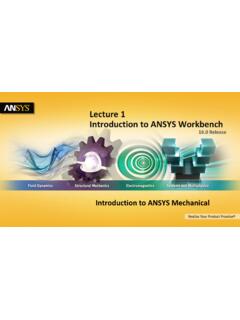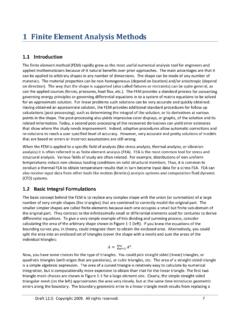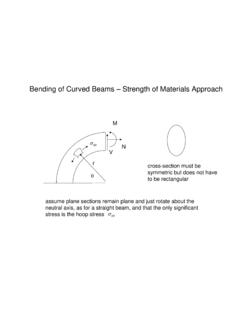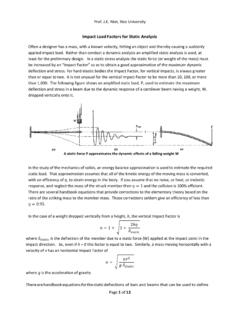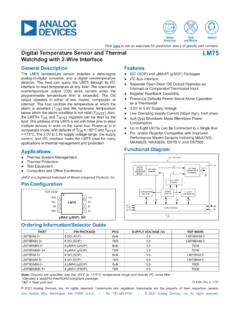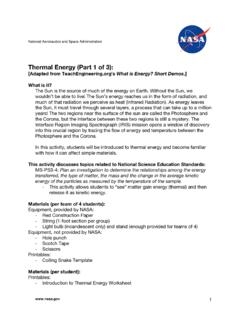Transcription of Lecture 9 Thermal Analysis - Rice University
1 1 2015 ANSYS, Inc. February 27, 2015 Release Lecture 9 Thermal Analysis Introduction to ANSYS Mechanical 2 2015 ANSYS, Inc. February 27, 2015 Chapter Overview In this chapter, performing steady-state Thermal analyses in Mechanical will be covered: A. Basics of Steady State Heat Transfer B. Geometry C. Material Properties D. Thermal Contact E. Thermal Boundary Conditions F. Solution Options G. Results and Postprocessing H. Workshop Pump Housing Note: advanced topics including Thermal transient analyses are covered in the ANSYS Mechanical Heat Transfer training course. 3 2015 ANSYS, Inc. February 27, 2015 A. Basics of Steady-State Heat Transfer The schematic setup for a steady-state (static) Thermal Analysis is shown here.
2 Later in this chapter we will shown the procedure for setting up a coupled Thermal structural Analysis . 4 2015 ANSYS, Inc. February 27, 2015 .. Basics of Steady-State Heat Transfer For a steady-state (static) Thermal Analysis in Mechanical, the temperatures {T} are solved for in the matrix below: Assumptions: No transient effects are considered in a steady-state Analysis [K] can be constant or a function of temperature {Q} can be constant or a function of temperature Fixed temperatures represent constraints {T} on the system (like fixed displacements on structures). It is important to remember these assumptions related to performing Thermal analyses in Mechanical.
3 TQTTK 5 2015 ANSYS, Inc. February 27, 2015 B. Geometry In Thermal analyses all body types are supported: Solid, surface, and line bodies. Line bodies cross-section and orientation is defined within DesignModeler or SpaceClaim. A Thermal Mass feature is available for use in transient Analysis (not covered in this course). Shell and line body assumptions: Shells: temperatures may vary over the surface (no through-thickness temperature variation) Line bodies: temperature may vary along the length of the beam (no variation across the cross section). 6 2015 ANSYS, Inc. February 27, 2015 C. Material Properties Thermal Conductivity is input in the Engineering Data application Temperature-dependent Thermal conductivity is input as a table The only required material property for steady state is Thermal conductivity.
4 If any temperature-dependent material properties exist, this will result in a nonlinear solution. 7 2015 ANSYS, Inc. February 27, 2015 D. Thermal Contact As with structural analyses, contact regions are automatically created to enable heat transfer between parts in assemblies. 8 2015 ANSYS, Inc. February 27, 2015 When can heat flow across a contact region? Thermal Contact Behavior: If parts are in contact heat transfer can occur between them. If parts are out of contact no heat transfer takes place. For bonded and no separation the pinball can be expanded to allow heat transfer across a gap. Initially TouchingInside Pinball RegionOutside Pinball RegionBondedYesYesNoNo SeparationYesYesNoRoughYesNoNoFrictionle ssYesNoNoFrictionalYesNoNoContact TypeHeat Transfer Between Parts in Contact Region?
5 Thermal Contact 9 2015 ANSYS, Inc. February 27, 2015 If the contact is bonded or no separation, then heat transfer will occur when the surfaces are within the pinball radius. Pinball Radius In this figure, the gap between the two parts is larger than the pinball region, so no heat transfer will occur between the parts.. Thermal Contact 10 2015 ANSYS, Inc. February 27, 2015 .. Thermal Contact By default, perfect Thermal contact is assumed, meaning no temperature drop occurs at the interface . Numerous real world conditions can contribute to less than perfect contact conductance: Surface roughness surface finish Oxides trapped fluids contact pressure surface temperature lubricants Etc.
6 Continued .. DT T x 11 2015 ANSYS, Inc. February 27, 2015 By default, TCC ( Thermal Contact Conductivity) is set to a high value based on the size and material conductivities in the model. This essentially provides perfect conductance between parts. A lower TCC value can be set in the contact details to provide a Thermal resistance. contacttargetTTTCCq The amount of heat flow across a contact interface is defined by the contact heat flux expression q shown here: Tcontact is the temperature of the contact surface and Ttarget is the temperature of the target surface.. Thermal Contact 12 2015 ANSYS, Inc. February 27, 2015 Spot welds provide discrete contact locations where heat transfer can take place.
7 T1 T2 .. Thermal Contact 13 2015 ANSYS, Inc. February 27, 2015 E. Thermal Boundary Conditions Heat Flow: A heat flow rate can be applied to a vertex, edge, or surface. Heat flow has units of energy/time. Heat Flux: Heat flux can be applied to surfaces only (edges in 2D). Heat flux has units of energy/time/area. Internal Heat Generation: An internal heat generation rate can be applied to bodies only. Heat generation has units of energy/time/volume. A positive value for heat load will add energy to the system. 14 2015 ANSYS, Inc. February 27, 2015 Perfectly insulated (heat flow = 0): Remove part of an applied boundary condition.
8 NOTE: adiabatic (perfectly insulated) is the default condition where no boundary condition is applied. Therefore, Perfectly Insulated is ONLY necessary to remove part of a previously applied BC or to define a symmetry region. A convection load is scoped to the entire body. A perfectly insulated condition removes the selected faces from the convection .. Thermal Boundary Conditions 15 2015 ANSYS, Inc. February 27, 2015 .. Thermal Boundary Conditions Temperature, Convection and Radiation: At least one type of Thermal condition containing temperature {T} should be present to bound the problem (prevent the Thermal equivalent of rigid body motion).
9 Temperature: Imposes a temperature on vertices, edges, surfaces or bodies. Convection: Ambient temperature Radiation: Ambient temperature ambientsurfacecTThAq 44ambientsurfaceRTTFAq T16 2015 ANSYS, Inc. February 27, 2015 Convection: Applied to surfaces only (edges in 2D analyses). Convection q is defined by a film coefficient h, the surface area A, and the difference in the surface temperature Tsurface & ambient temperature Tambient h and Tambient are user input values. The film coefficient h can be constant, temperature or spatially dependent (only temperature dependent is covered in this course). ambientsurfacecTThAq.
10 Thermal Boundary Conditions 17 2015 ANSYS, Inc. February 27, 2015 To define temperature dependent convection: Select Tabular for the film coefficient. Set the independent variable to temperature . Enter coefficient vs temperature tabular data. In the Coefficient Type field, specify how temperature from the table is to be interpreted. Note: as shown (above right), other independent variables are available for tabular data. These are not covered in this course.. Thermal Boundary Conditions 18 2015 ANSYS, Inc. February 27, 2015 Once defined convection correlations can be exported to a convection library for reuse. Several common text book correlations are available to import from a Workbench sample library.
